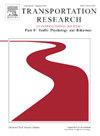使用对照实验分析行人和骑自行车者在与自主系统交互中的行为:文献综述
IF 3.5
2区 工程技术
Q1 PSYCHOLOGY, APPLIED
Transportation Research Part F-Traffic Psychology and Behaviour
Pub Date : 2025-06-10
DOI:10.1016/j.trf.2025.05.031
引用次数: 0
摘要
随着自动驾驶汽车、自动公交车、人行道配送机器人等自动驾驶系统的出现,城市交通将发生深刻的变化。为了促进安全、可持续和包容的城市交通,理解和预测行人和骑自行车者的行为,包括他们与自主系统互动时的意图、决策和运动变得至关重要。深入了解这些复杂的相互作用不仅可以提高自主系统的安全性、效率和可接受性,还可以增强这些技术的设计和实现。通过对2014年至2023年的文献进行全面回顾,我们确定了99篇实证研究人类与自治系统相互作用的文章。基于我们对该领域进展和挑战的概述,我们进一步确定了未来研究应该解决的五个研究缺口,以增强人类自主系统的相互作用,包括:(1)将实验场景扩展到多用户和多模态设置,以更好地代表现实世界的挑战;(2)强调通过应用虚拟现实在现实环境中难以实现的安全关键场景;(3)从人类角度整合各种行为数据,以加深对脆弱道路用户行为和决策的理解;(4)拥抱持续和实时交互,以更好地预测动态的未来环境。(5)提高归纳能力,保证真实感和广泛适用性。这篇综述文章为不断发展的人类自主系统研究界提供了有价值的见解,特别是那些对利用控制实验来增强对未来城市环境中行人和骑自行车者行为的理解和预测感兴趣的人。本文章由计算机程序翻译,如有差异,请以英文原文为准。
Analyzing the behaviors of pedestrians and cyclists in interactions with autonomous systems using controlled experiments: A literature review
Urban transportation is set to undergo a profound transformation with the advent of autonomous systems such as autonomous vehicles, automated buses, and sidewalk delivery robots. To promote safe, sustainable, and inclusive urban mobility, understanding and predicting the behaviors of pedestrians and cyclists, including their intentions, decisions, and movements, when they interact with autonomous systems becomes crucial. Gaining a thorough understanding of these complex interactions can not only improve the safety, efficiency, and acceptance of autonomous systems but also enhance the design and implementation of these technologies. Through a comprehensive review of the literature spanning the years 2014 to 2023, we identify 99 articles that empirically investigate the interactions of humans and autonomous systems. Based on our overview of progress and challenges within this field, we further identify five research gaps that future research should address to enhance human-autonomous system interactions, including: (1) scaling up experimental scenarios to multi-user and multi-modal setups to better represent real-world challenges, (2) emphasizing safety-critical scenarios that are difficult to achieve in real-world environments by applying virtual reality, (3) incorporating diverse behavioral data from the human perspective to deepen the understanding of vulnerable road user behavior and decisions, (4) embracing continuous and real-time interaction to better predict dynamic future environments, and (5) enhancing the generalization ability to ensure realism and broad applicability. This review article offers valuable insights for the growing human-autonomous system research community, specifically those interested in leveraging controlled experiments to enhance the understanding and prediction of pedestrians' and cyclists' behaviors in future urban environments.
求助全文
通过发布文献求助,成功后即可免费获取论文全文。
去求助
来源期刊
CiteScore
7.60
自引率
14.60%
发文量
239
审稿时长
71 days
期刊介绍:
Transportation Research Part F: Traffic Psychology and Behaviour focuses on the behavioural and psychological aspects of traffic and transport. The aim of the journal is to enhance theory development, improve the quality of empirical studies and to stimulate the application of research findings in practice. TRF provides a focus and a means of communication for the considerable amount of research activities that are now being carried out in this field. The journal provides a forum for transportation researchers, psychologists, ergonomists, engineers and policy-makers with an interest in traffic and transport psychology.

 求助内容:
求助内容: 应助结果提醒方式:
应助结果提醒方式:


